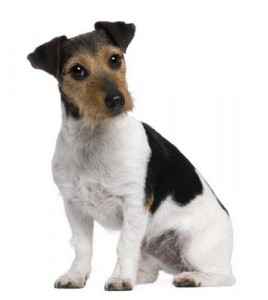Learning how to brush your Russell Terrier is an important first step in the grooming process, because it’s the best way to remove dead hair from his coat and any dirt or debris that he picks up outside. It will also give his coat a healthy gloss by stimulating the natural oils in his skin. Brushing also feels good, so it’s a great way to get your boy used to being groomed.
You can brush his back, chest, sides, legs, and ears. Do not brush around the face or eye area. Instead use a moist washcloth for these delicate areas. Depending on his coat, you’ll need different tools to brush him effectively. For smooth coats, use a firm, natural bristle brush. After brushing him down, go over the area with a metal comb to catch any stray hairs.
For broken rough coats, use a slicker brush to remove excess hair, dirt, and debris that gets nestled. Then go over him with a stripping tool to give him a nice, finished look and remove any excess hair. When your “strip” your boy’s coat, you are removing the dead hair so a new wire coat can grown in.
A stripping knife is used instead of a clipper because unlike the clipper, it doesn’t “cut” hair but “pulls” it out by gripping the hair, thus maintaining the proper wire texture. It does not hurt the dog. Wire hair is not attached in the same way flat hair is. Most dogs enjoy being stripped once they get used to it. The Furminator is a great patented de-shedding tool that can be used on both coat types. It quickly removes loose, dead hair without damaging the dog’s topcoat.
There is nothing more pleasing to the eye than a clean, well-groomed Russell. Just remember what your mother said: “Cleanliness is next to godliness!” The more active your Russell, the more you will appreciate this old adage. It’s a fact of nature.
A normal, healthy Russell is more likely than not to come into the house from play needing a good brushing or hosing down. It’s just part of young Jack’s charm. When he’s out in the yard, he’s in his element: running, frolicking, rolling around, digging, and investigating, and that could make for one messy pup by the end of the day.
Don’t think that just because he’s a short-coated dog, he doesn’t require regular brushing. Even if your Russell doesn’t crave daily mud rolls, he’s bound to pick up burrs, and other vegetation when he’s outdoors. Furthermore, the Russell is a shedding breed. So, if you don’t want to see tenacious little white hairs all over your carpets and furniture, get into the habit of giving him a good brushing or combing before he turns in for the night.
Russells come in two coat types, smooth and broken or rough, which can be distinguished as follows: the smooth coat is short and lies flat along his body; the broken or rough coat has a smooth undercoat with longer, wiry guard hairs lying on top. Typically the rough coat gives the Russell his signature scruffy look. Although both of these coats shed, many owners swear that their smooth‑coated Russells shed the most.
Helpful Tip: Being a curious and high-spirited Russell isn’t easy, but somebody’s got to do it! If he comes in from the yard smelling like he’s been on intimate terms with a skunk, do not dunk him in a vat of tomato juice. It won’t do the trick.
Instead head for your pet or feed store and buy a commercial de-skunking solution. Also never use turpentine, paint thinner, or kerosene on your Russell to remove yucky things like tar, paint, or sap. Instead, use petroleum jelly followed by a bath.

